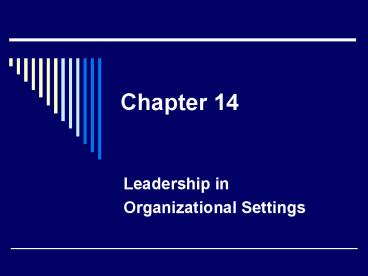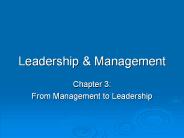Leadership in - PowerPoint PPT Presentation
1 / 20
Title: Leadership in
1
Chapter 14
- Leadership in
- Organizational Settings
2
Chapter Outline
- Emerging View of Leadership
- Perspectives of Leadership
- Competency/Trait Perspective
- Behavioral Perspective
- Contingency Perspective
- Path-Goal Theory
- Transformational Perspective
- Cross-Cultural Issues in Leadership
- Gender Issues in Leadership
3
Emerging View of Leadership
- Leadership ability to influence, motivate,
enable - others to contribute to the effectiveness
success - of the organization.
- Application of power
- Ensure followers have motivation role clarity
- Arrange work environment resources
- Teach empower employees
- Subordinate own ego nurture leadership in
others
4
Perspectives of Leadership
Competency Trait/Perspective
Leadership Perspectives
Behavioral Perspective
Transformational Perspective
Contingency Perspective
5
Perspectives of LeadershipCompetency Perspective
- Characteristics of Effective Leaders
- Emotional Intelligence
- Integrity
- Drive
- Leadership Motivation
- Self-confidence
- Intelligence
- Knowledge of the Business
6
Perspectives of LeadershipCompetency Perspective
- Limitations
- Competencies indicate potential, not actual
performance - Implies a universal approach
- Probably false assumption
- Implications
- Organizations increasingly relying on
competency-based hiring - Extends to all levels
7
Perspectives of LeadershipBehavioral Perspective
- People-oriented Behaviors
- Showing mutual trust respect
- Concern for employee needs
- Treat employees as equals
- Task-oriented Behaviors
- Assign specific tasks
- Clarify work duties procedures
- Ensure employees follow rules
- Push employees to reach peak performance
8
Perspectives of LeadershipBehavioral Perspective
- PEOPLE-ORIENTED
- Advantages
- Higher job satisfaction
- Lower absenteeism
- Lower turnover
- Disadvantages
- Lower job performance
- TASK-ORIENTED
- Advantages
- Higher productivity
- Disadvantages
- Lower job satisfaction
- Higher absenteeism
- Higher turnover
9
Perspectives of LeadershipBehavioral Perspective
People-oriented
Task-oriented
VS
- The 2 styles are independent
- Effective leaders exhibit high levels of both?
- The best style depends on the situation
10
Perspectives of LeadershipContingency
Perspective
- Effective leaders must
- Be insightful flexible
- Have high emotional intelligence
- Have a self-monitoring personality
- Know their preferred style, be able to adapt
11
Perspectives of LeadershipContingency
Perspective
- Path-Goal Theory
- Advocates Servant Leadership
- Roots in expectancy theory of motivation
12
Perspectives of LeadershipContingency
Perspective
- Path-Goal Theory
- Effective leaders
- Increase performance-to-outcome expectancy
valences - Better performers have higher degree of need
fulfillment - Increase effort-to-performance expectancy
- Providing info, support, other resources
13
Perspectives of LeadershipContingency
Perspective
- Path-Goal Theory Leadership Styles
- Directive
- Task-oriented Behaviors
- Supportive
- People-oriented Behaviors
- Participative
- Encouraging employee involvement in decisions
- Achievement-oriented
- Using goal setting positive self-fulfilling
prophecy
14
Perspectives of LeadershipContingency
Perspective
- Path-Goal Theory
- Situational Variables help determine the most
- effective leadership style for the given
situation - Employee Cont.
- Skills experience
- Locus of control
- Environmental Cont.
- Task structure
- Team dynamics
15
Path-Goal Theory
- Skill/Experience low low high high
- Locus of Control external external internal intern
al
Task Structure nonroutine routine nonroutine
? Team Dynamics norms low cohesion
norms ?
16
Perspectives of LeadershipTransformational
Perspective
- Transformational leaders
- Change the organization to fit the environment
- Develop, communicate, enact a vision
- Transactional leaders
- Manage -- link job performance to rewards
- Ensure employees have necessary resources
- Apply contingency leadership theories
17
Perspectives of LeadershipTransformational
Perspective
Creating a Vision
Building Commitment
Transformational Leadership
Communicating the Vision
Modeling the Vision
18
Perspectives of LeadershipTransformational
Perspective
- Consequences
- Higher employee satisfaction
- Higher affective commitment
- Better job performance
- More organizational citizenship behavior
- Conditions
- More appropriate in very dynamic environments
19
Cross-Cultural Issuesin Leadership
- Culture shapes leaders values norms
- Culture shapes followers expectations
- Leaders acting inconsistently with cultural
expectations are perceived as ineffective
20
Gender Issues in Leadership
- Male female leaders have similar task and
people-oriented leadership - Women are evaluated negatively when they adopt a
stereotypical male leadership style - Women adopt a participative leadership style more
readily - Consistent with todays workforce expectations































